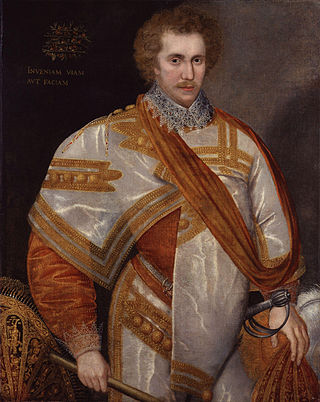Related Research Articles

Robert Sidney, 1st Earl of Leicester, was an English courtier, soldier, and landowner. He was chamberlain to Anne of Denmark.

Thomas Sackville, 1st Earl of Dorset was an English statesman, poet, and dramatist. He was the son of Richard Sackville, a cousin to Anne Boleyn. He was a Member of Parliament and Lord High Treasurer.

Lady Mary Wroth was an English noblewoman and a poet of the English Renaissance. A member of a distinguished literary family, Lady Wroth was among the first female English writers to have achieved an enduring reputation. Mary Wroth was niece to Mary Herbert née Sidney, and to Sir Philip Sidney, a famous Elizabethan poet-courtier.

The Whitefriars Theatre was a theatre in Jacobean London, in existence from 1608 to the 1620s — about which only limited and sometimes contradictory information survives.
The High Sheriff of Essex was an ancient sheriff title originating in the time of the Angles, not long after the invasion of the Kingdom of England, which was in existence for around a thousand years. On 1 April 1974, under the provisions of the Local Government Act 1972, the title of Sheriff of Essex was retitled High Sheriff of Essex. The high shrievalties are the oldest secular titles under the Crown in England and Wales, their purpose being to represent the monarch at a local level, historically in the shires.
George Howard, 4th Earl of Suffolk was an English peer.
Sir Thomas Wroth was an English courtier, landowner and politician, a supporter of the Protestant Reformation and a prominent figure among the Marian exiles.
Sir Robert Wroth was an English politician.
Henry Atkins (1558–1635) was an English physician.
Sir Richard Cockburn of Clerkington, Lord Clerkintoun (1565–1627) was a senior government official in Scotland serving as Lord Privy Seal of Scotland during the reign of James VI.

Sir David Murray of Gorthy (1567–1629) was an officer in the household of Henry Frederick, Prince of Wales, in England from 1603 to 1612, and poet.

Loughton Hall is a large house in Rectory Lane, Loughton, Essex. The architect was William Eden Nesfield, and it is grade II listed with Historic England. It is now a 33-bedroom residential care home for elderly people.

Frances Howard, Countess of Kildare, was a courtier and governess of Princess Elizabeth Stuart, Queen of Bohemia, and a member of the House of Howard.
Mary Middlemore was a Courtier and Maid of Honour to Anne of Denmark, subject of poems, and treasure hunter.

Elizabeth Howard (1564—1646) was an English aristocrat and courtier to Elizabeth I of England.
Stephen Lesieur or Le Sieur was a Swiss-born English ambassador to Denmark, Florence, and the Holy Roman Empire.
Sir Francis Gofton was an English courtier and administrator. He was an auditor of royal accounts and jewels, Chief Auditor of the Imprest from 1597 and Auditor of Mint from August 1603. Gofton acquired the manor of Heathrow, and houses in Stockwell and West Ham. He was often called "Auditor Gofton". The surname is frequently transcribed as "Goston" or "Guston"
John Elphinstone of Selmes and Baberton (1553-1614) was a Scottish landowner and courtier.
Nicholas Stallinge or Stallenge was an English courtier.
John Crane was a soldier and comptroller of works at Berwick-upon-Tweed during the reigns of Elizabeth I and James VI and I.
References
- ↑ "WROTH, Sir Robert II (c.1576-1614), of Durants, alias Gartons, Enfield, Mdx. and Loughton Hall, Essex | History of Parliament Online". www.historyofparliamentonline.org. Retrieved 2023-12-20.
- ↑ John Nichols, Progresses of James the First, vol. 1 (London, 1828), p. 166.
- ↑ HMC Salisbury Hatfield, vol. 17 (London, 1938), p. 364.
- ↑ John Nichols, Progresses of James the First, vol. 1 (London, 1828), pp. 517-8.
- ↑ William Chapman Waller, 'An Extinct County Family: Wroth of Loughton Hall, I', Transactions of the Essex Archaeological Society, 8:2 (Colchester, 1901), p. 158.
- ↑ HMC Salisbury Hatfield, vol. 20 (London, 1968), p. 120.
- ↑ There are two copies of this petition, see; HMC Salisbury Hatfield, vol. 20 (London, 1968), p. 315, endorsed "1608": HMC Salisbury Hatfield, vol. 23 (London, 1974), p. 123, endorsed "1603".
- ↑ HMC Salisbury Hatfield, vol. 22 (London, 1971): William Chapman Waller, 'An Extinct County Family: Wroth of Loughton Hall, I', Transactions of the Essex Archaeological Society, 8:2 (Colchester, 1901), pp. 162-3.
- ↑ William Chapman Waller, 'An Extinct County Family: Wroth of Loughton Hall, I', Transactions of the Essex Archaeological Society, 8:2 (Colchester, 1901), p. 163 fn.2.
- ↑ Andrew Thrush, 'WROTH, Sir Robert II (c.1576-1614), of Durants, alias Gartons, Enfield, and Loughton Hall, Essex', The History of Parliament: the House of Commons 1604-1629, ed. Andrew Thrush and John P. Ferris, 2010.
- ↑ William Chapman Waller, 'An Extinct County Family: Wroth of Loughton Hall, I', Transactions of the Essex Archaeological Society, 8:2 (Colchester, 1901), p. 164.
- ↑ David Norbrook, Poetry and Politics in the English Renaissance (Oxford, 2002), pp. 168-70.
- ↑ Martin Elsky, 'Microhistory and Cultural Geography: Ben Jonson's 'To Sir Robert Wroth' and the Absorption of Local Community in the Commonwealth', Renaissance Quarterly, 53:2 (2000), pp. 500-528.
- ↑ Margaret Hannay, Mary Sidney, Lady Wroth (Ashgate, 2010), pp. 155-6.
- ↑ William Chapman Waller, 'An Extinct County Family: Wroth of Loughton Hall, I', Transactions of the Essex Archaeological Society, 8:2 (Colchester, 1901), p. 159.
- ↑ Thomas Birch & Folkestone Williams, Court and Times of James the First, vol. 1 (London, 1848), p. 418.